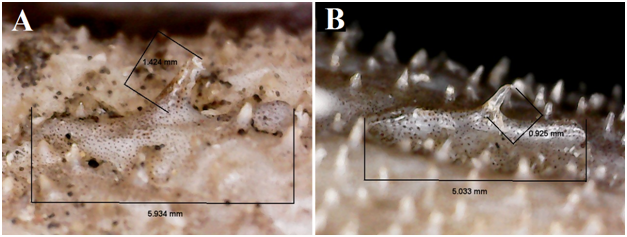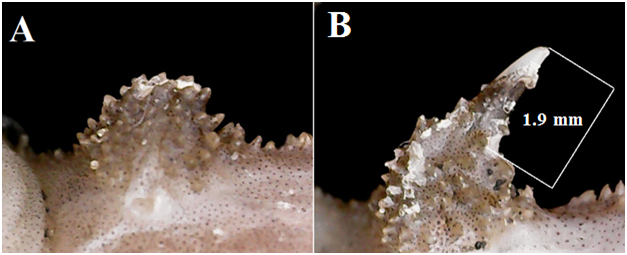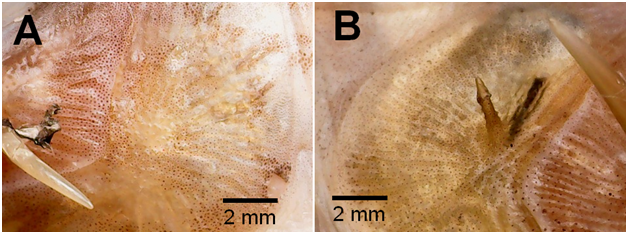Journal of
eISSN: 2378-3184


Research Article Volume 7 Issue 6
Laboratory of Ichthyology Zoological Institute Russian Academy of Sciences Russia
Correspondence: Mikhail Yur evich Zhukov Laboratory of Ichthyology Zoological Institute Russian Academy of Sciences Universitetskaya emb 1 St Petersburg 199034 Russia
Received: October 01, 2018 | Published: November 6, 2018
Citation: Zhukov MY. The redescription of topology of cranial spines with their relationship to seismosensory system in genus Zanclorhynchus (Zanclorhynchinae: Congiopodidae), Southern Ocean. J Aquac Mar Biol. 2018;7(6):297?301. DOI: 10.15406/jamb.2018.07.00224
The goal of this work is to redescribe the topology of cranial spines of Zanclorhynchus using nomenclature that corresponds the position of spine to its sense in seismosensory system. The individual variability was examined, that explains some previously published data.
Keywords: Zanclorhynchus, cranial spines, seismosensory system, southern ocean
The genus Zanclorhynchus Günther, 1880 inhabits shelves of the islands and seamouts in the Indian and Pacific sectors of the Southern Ocean - Kerguelen Islands,1 Macquarie Island,2 Crozet and Heard Islands,3 Kara-Dag Bank,3 Prince Edward Islands,4 and Ridge of Hercules.5 In some cases that fishes appears in significant quantity.6,7 Despite this, until recently, the morphology was not sufficiently described.
The location of some cranial spines was published in description and redescription of Zanclorhynchus spinifer1,2, and partly mentioned in several articles.8,9 Only in last years the articles were published with the description of the exact location of cranial spines with a proposal of a new nomenclature, according to their correspondence to the senses sensu Balushkin10 of the cephalic canals of the lateral line.5,11 Sense here is a segment of seismosensory system between two main pores, which contains one neuromast in contrast to hypersense, which have several neuromasts (PMI-III and SOIV-V), or pseudosense without them (absent in this genue).
87 specimens have been examined
Z.chereshnevi: ZIN no. 56046 (Holotype) TL 252mm, SL 200mm, MFFT “Aelita”, Prince Edward Islands, 46°55′ S37°58′E, depth 170m, January 18, 1968, bottom trawl, collectors Karpenko A.I. and Volya G.S.; ZIN no. 45674 (Paratypes)−four specimens, TL 209−251mm, SL 165−203mm, sampled in the same trawl with ZIN no. 56046.
Z.spinifer: ZIN no. 39410–TL 58mm, SL 48мм, “Ob’”, station no. 121, off Kerguelen Island, 49°39'S, 70°43'E, depth 140m, 20.05.1956, collectors Andriashev A.P. and Tokarev A.K.; ZIN no. 40248–26 specimens, SSS “Skif”, cruise no. 3, station no. 944/33, trawl no. 18, Crozet Islands, 45°51ʹS, 49°47ʹE, depth 235-260м, 04.12.1970, collector Pushkin A.F.; ZIN no. 40508−ten specimens, TL 270−123mm, SL 220−96mm, FRV “Skif”, cruise no. 3, station no. 1125/214, Kerguelen Island, 48°22 S 68°57 E, depth 131m, January 11, 1971, collector Pushkin A.F.; ZIN no. 45673−two specimens, TL 280 and 245mm, SL 231 and 194mm, FRV “Skif”, trawl no. 377, January 19, 1970, collector Kononov N.V.; ZIN no. 45675–4 specimens, MFFT “Aelita”, station no. 41, Crozet Islands, 45°52 ʹ S, 49°54ʹE, depth 230м, 25.01.1968, collectors Karpenko A.I. and Volya G.S.; ZIN no. 56301–14 specimens, sampled in the same trawl with ZIN no. 40248; ZIN no. 45684−two specimens, TL 134 and 174mm, SL 105 and 138mm, FRV “Skif”, cruise no. 3, trawl no. 38, Kerguelen Island, 48°57 S 67°27 E, depth 195–207m, December 10,1970, collector Pushkin A.F. ; ZIN no. 45685−TL 142mm, SL 114mm, FRV “Skif”, cruise no. 3, trawl no. 44, Kerguelen Island, 49°51′ S 70°31′E, depth 220m, December 12,1970, collector Pushkin A.F.; ZIN no. 45686−TL 155mm, SL 124mm, FRV “Skif”, cruise no. 3, trawl no. 54, Kerguelen Island, 49°55 S 70°33 E, depth 215–225m, December 13, 1970, collector Pushkin A.F.; ZIN no. 45687−TL 228mm, SL 185mm, FRV “Skif”, cruise no. 3, trawl no. 83, Kerguelen Island, 47°52′ S 70°44′ E, depth 153m, December 22, 1970, collector Pushkin A.F.; ZIN no. 45688−TL 221mm, SL 181mm, FRV “Skif”, cruise no. 3, trawl no. 97, Kerguelen Island, 48°01′ S 70°27′ E, depth 146m, December 25, 1970, collector Pushkin A.F.; ZIN no. 45692−four specimens, TL 143–161mm, SL 112–130 mm, FRV “Skif”, cruise no. 3, trawl no. 123, Kerguelen Island, 50°12′ S 69°18′ E, depth 197m, January 5, 1971, collector Pushkin A.F.; ZIN no. 45693−TL 247mm, SL 201mm, FRV “Skif”, trawl no. 138, Kerguelen Island, 48°00′S 70°29′E, depth 152m, January 11, 1971, collector Pushkin A.F.; ZIN no. 56301−14 specimens, TL 136−187 мм , SL 105−147mm, FRV “Skif”, cruise no. 3, station no. 944/33, trawl no. 18, Crozet Islands, 45°51' S, 49°47'E, depth 235–260м, 04.12.1970, collector Pushkin A.F.
Every scale and every tubular segment of lateral line on body have a spine (Figure 1). Spines on the head developed only on several senses of the cephalic canals of the lateral line; on others the development is terminated. Also most of the small bony granules (tubercules) in the skin of the head have spines too, which in some cases may develop to additional spines.

Figure 1 Tubular segments of lateral line of the body surrounded by spiny scales: A and B– third and seventh tubular segments of lateral line of the body respectively, Z. spinifer ZIN no. 40248(25), TL 181mm, SL 144mm.
Waite2 in his article, describing 2 specimens off Macquarie Island, mentioned one spine above the nostril (sSO–nasal spine in our terminology, corresponding to the sense SOI, Figure 2), a minute one below it (sIOI–lacrimal spine), one in continuation of the supraorbital ridge (sSOIII–suborbital spine), two above the preopercle, of which the anterior one is small (sIOVI and sTI–spine on dermosphenoticum and postorbital spine), a very large above the opercle (sTII–posttemporal spine), one on a cheek below the hinder half of the eye (sIOIII–suborbital spine), one on each side immediately in front of the first dorsal spine (sSTII–parietal spine). Also Waite mentioned a large spine above the base of the pectoral fin (sCl–cleithral spine).

Figure 2 (A) General scheme of the location of pores and senses of the seismosensory system of the head of Zanclorhynchus.
Abbreviations: ppm1–ppm8, PMI-III–PMVII, praeoperculum-mandibular canal (CPM); pio1–pio7, IOI, IOVIinfraorbital canal (CIO); pso1–pso3, SOI, SOIV-V–supraorbital canal (CSO); pt1–pt2, TI, temporal canal; pst1–pst3, STI–STII, supratemporal commissure (CST); pcor, pore of the coronal commissure (CC); (--) margins of the senses.
(B) Scheme of the location of cranial spines of Zanclorhynchus: sSOI, sSOIII–supraorbital spines (nasal and supraorbital); sIOI, sIOIII, sIOVI–infraorbital spines (lacrimal, suborbital and on dermospenoticum); sTI, sTII–temporal spines (postorbital and posttemporal); sSTII, supratemporal (parietal) spine; sPMV, praeoperculum-mandibular (praeopercular) spine; sСl, cleithral spine.
In remarks Waite compare his material with the original Günther description1, where several spines were not mentioned: sSTII, sIOI and sIOVI. Waite made a conclusion that it is because of the different age of the fishes. Holotype is only 90mm long; his material was 202 and 238mm.
In this work it may be decisively approved that sSTII and sIOI are present on all Zanclorhynchus, even a juvenile ones. The spines on dermosphenoticum appear to be only on two examined specimens, what means that the absence of that spine on Holotype is not surprising (Figure 3). Nevertheless, Günther1 draw the sTI originating just after the orbit of the eye, on the place of the sIOVI (Figure 4). It is certainly a mistake, because there are only two temporal spines on the figure, both are quite strong. The spine on dermosphenoticum in examined material is much smaller than temporal spines, which are present in all examined specimens in contrast with sIOVI. The same mistake was made by artist in Hureau12 paper (Figure 5).

Figure 3 Spine on dermosphenoticum: A – absent, Z. spinifer ZIN no. 40248(17), TL 180mm, SL 145mm; B– present, Z. spinifer ZIN no. 40248(26), TL 187mm, SL 148mm.
The parietal spines were not mentioned in Günther1, as noted Waite2, but they are clearly drawn on the left image of original picture (Figure 4). They are present on all examined Z. spinifer. But the real spine is developed only in several cases. Mostly it appears as the sharp prominence. The complete absence of that spine is one of the keys to determine Z. chereshnevi (Figure 6).

Figure 6 Parietal spine. (A) developed spine, Z. spiniferZIN no. 56301(1) TL 146mm, SL 114mm. (B)sharp prominence, Z. spiniferZIN no. 56301(12) TL 136mm, SL 105mm. (C)absent, Z. chereshnevi ZIN no. 45674(4) TL 251mm., SL 203mm.

Figure 7 The praeopercular spine. (A) absent, Z. spiniferZIN no. 56301(2) TL 168mm, SL 134mm, left side; (B) present, Z. spiniferZIN no. 56301(11) TL 177mm, SL 141mm, right side.
The praeopercular spine, which is not mentioned niether by Günther, nor by Waite, was present on about 15% of examined fishes (Figure 7), what is much more often than occurrence of the spine on dermospenoticum. It could present on both sides or only on one.
Waite2 also described in remarks an “auxiliary prong” on the sTII on one specimen. He decided that it is developed on all adult Antarctic horse fishes, and its absence on another specimen he explained by worning down that “spine below the point whence the prong originates”. Its absence on Holotype was explained by its small length. Highly likely that prong was the additional spine, which originated from bony granules in skin and then eventually firmly fuses with the main spine (Figures 8A & 8B). This is not an unusual case; about ¼ of examined Zanclorhynchus spinifer have such a spines in various degrees of development and locations. They are often located on strong main spines, but in some cases they could be found on other positions on the head and even on the spines of the first dorsal fin (Figure 8C).
On one specimen Z. spinifer ZIN no. №56301(10) the double spine was found under the eye. Here it couldn’t be the main and the additional spines because of the equal length of those spines; especially they are the doubled on both sides of the head. It might be explained by the activation of development of spine on next sense, which is usually terminated. So in this case it is two spines sIOIII+sIOIV grown together because of close location (Figure 9).
The study was supported by the State Research Program no. AAAA-A17-117030310197-7.
The author is grateful to the collectors Karpenko A.I., Volya G.S., Andriashev A.P., Tokarev A.K., Pushkin A.F., Kononov N.V. Special thanks to the Balushkin A.V. and Yurtseva A.O. (ZIN RAS) for a discussion of the work.
The author declares that there is no conflict of interest.

©2018 Zhukov. This is an open access article distributed under the terms of the, which permits unrestricted use, distribution, and build upon your work non-commercially.